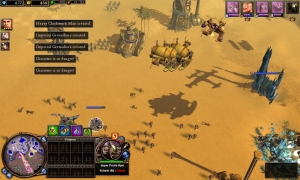The original Warhammer 40,000: Dawn of War came out to rave reviews all the way back in 2004, but I didn’t play it until a few months ago, when I jumped into the Dark Crusade expansion. And I liked it! But it wasn’t perfect. In the process, Dark Crusade showed me how one element of gameplay should work… and how the very same element shouldn’t.
By way of background, most of the levels in the Dark Crusade campaign are just ordinary skirmish-style matches against one or more computer opponents. Here, the AI is more or less playing the same game as the human. A few, in contrast, are “stronghold” battles, which are more in line with traditional RTS campaign levels. The stronghold battles are hand-crafted affairs featuring special victory conditions, scripted events tied to particular locations, and more puzzle-like computer opponents.
Now, based solely on “ordinary skirmish” vs “hand-crafted affair”, you might think that the stronghold battles offer the superior gameplay experience and that the other campaign levels are just filler. But my experience was Dark Crusade was the complete opposite: I had the most fun with some of the skirmish-type battles, while the strongholds left me groaning. Why?
In a word, pacing. By “pacing”, I don’t just mean the game speed, although that is part of it. I mean the structure of a given match, how it unfolds, when it’s most exciting or challenging, and when it’s least.
Played on the right map, against multiple computer opponents, the pacing of the ordinary maps* in Dark Crusade was marvellous. If there were two computer players and only one of me, this forced me to quickly locate my foes, and then either successfully rush one, or keep them both bottled up while I out-teched them. If I took too long, either the superior enemy numbers would overwhelm me or else the second computer player would tech up and roll over me with top-tier units while I was still dealing with the first one. The actual speed of the game was also just right: fast enough to have a sense of urgency, fast enough for the match not to take too long, fast enough so that I could replay a stage if I lost. At the same time, it wasn’t so fast that I found it unmanageable, and in particular, it didn’t require me to split my attention amongst 20 different things (and thus it avoided the fate of Company of Heroes, from the same developer, which ended up as an exercise in frustration for me).
In contrast, I found that the strongholds fell flat for several reasons. The basic structure of the stronghold mission is that you have to fight off an onslaught in the first 30 seconds, when your forces are at their weakest… but after that the enemy attacks die down to a constant, annoying trickle. The computer players in stronghold missions didn’t build bases, they didn’t tech up, they didn’t come at me in increasing force. But (appropriately enough) they were very well-entrenched. And so, after I survived that initial rush, the strongholds degenerated into (1) maxing out my forces while fending off the continuing trickle, then (2) laboriously rolling over the excessively large maps. To put things another way, the challenge in the normal maps was high and stayed that way throughout the entire 30 minutes, or however long it took me to play; the challenge in the stronghold missions started high, plummeted after 30 seconds, and stayed boringly low for the rest of the loooong maps.
All in all, I really liked the Dark Crusade campaign and I walked away from the game thinking, “So that’s what all the fuss was about!” But that was no small thanks to the fact that the campaign has many more ordinary than stronghold missions. The former were tense, exciting, well-paced; the latter too long, too grindy, and an example of the complaints I often hear voiced about RTS campaigns. The combination of the two, I think, makes the Dark Crusade campaign a lesson in the importance of pacing to a strategy game.
* I only played one skirmish and one comp-stomp game of Dark Crusade, but from what I saw, they lived up to the high standard of the ordinary campaign maps.


